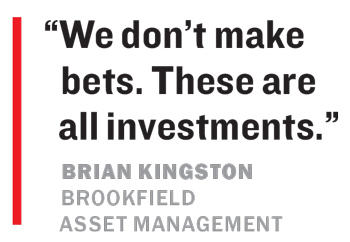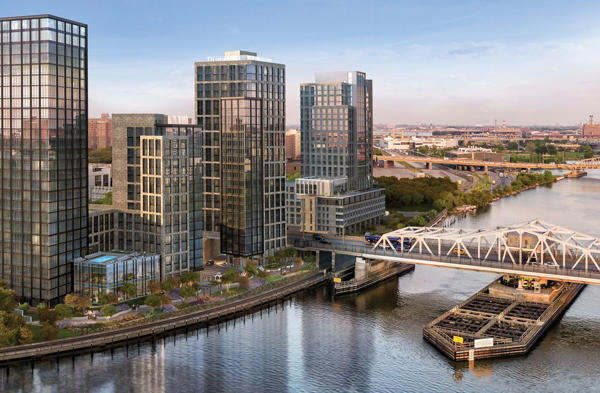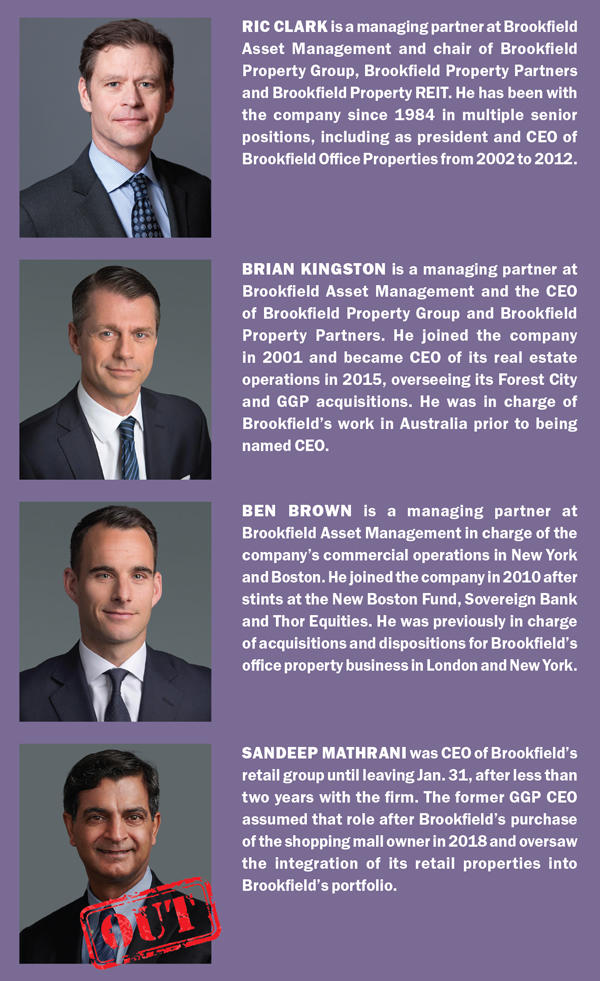Trending
How big can Brookfield get?
After swallowing Forest City and digesting dozens of shopping malls, the Canadian colossus still has an appetite for growth

You don’t become the city’s biggest commercial landlord without taking some big risks.
Buying malls when everyone says brick-and-mortar retail is dying. Building a megaproject in the South Bronx where other developers still fear to tread. Taking on 666 Fifth Avenue when the notorious office building’s reputation has lived up to its address.
Brookfield Asset Management did all of these things, all while taking on acquisitions that few other firms would be able to absorb.
How well these bets and buyouts will pay off remains to be seen, but the Toronto-based alternative asset manager isn’t worried. In fact, it views such contrarian investments as a key component of its business strategy.
“If you think about sectors right now, office and retail are both out of favor, and so they probably present numerous opportunities for deep value buys,” said Brian Kingston, CEO of Brookfield’s real estate operation. “Some other sectors are more highly sought after, and so it’s harder to find those opportunities. That’s not to say we would never do anything in industrial, but it does make it harder.”
At the end of 2018, Ric Clark, a managing partner at Brookfield Asset Management and chair of its real estate business, announced that the company was poised to become New York City’s largest commercial landlord following its $6.8 billion acquisition of Forest City Realty Trust. Brookfield now has about 26 million square feet of space across 25 office properties, as well as about 3 million square feet of retail space and 6,500 rental apartments in the city.
And these numbers could get even bigger moving forward. Although he declined to provide specifics, Kingston said it was highly likely that Brookfield would seek out more development and acquisition opportunities in the coming year.
“What we look for are opportunities where we can buy for good value,” he noted. “A need for some sort of hands-on operational expertise to really drive the returns, as opposed to just trying to bet on the interest rates.”
The Canadian colossus — which launched more than 120 years ago when it established the first electrical and transport utility in Brazil in 1899 and listed it on the Toronto Stock Exchange in the early 20th century — has become a sprawling operation with more than $500 billion in assets under management and investments in renewable energy, infrastructure and private equity in addition to its hefty real estate portfolio.
A few months before it closed on its acquisition of Forest City in 2018, Brookfield also purchased GGP for $14.8 billion and secured the ground lease for 666 Fifth Avenue for $1.3 billion. It also has major projects underway across the city, in neighborhoods ranging from Hudson Yards to Greenpoint to the South Bronx.
 “Because of the different expertises that they have, they can take down things like Forest City that has all the development activity as well as retail, as well as office and multifamily,” said RXR Realty CEO Scott Rechler. “They’re active across the whole spectrum.”
“Because of the different expertises that they have, they can take down things like Forest City that has all the development activity as well as retail, as well as office and multifamily,” said RXR Realty CEO Scott Rechler. “They’re active across the whole spectrum.”
And while Kingston acknowledged that virtually every Brookfield project involves some level of risk, he insisted that the firm believes in all of them.
“We don’t make bets,” he said. “These are all investments.”
Let’s go to the mall
Not everyone was convinced when the firm spent nearly $15 billion to buy out mall owner General Growth Properties in 2018, at a time when abandoned shopping malls had long since become one of the most prominent symbols of traditional retail’s decline.
Brookfield Property REIT’s share price took a hit after the acquisition, but Joseph French Jr., senior vice president at Marcus & Millichap who specializes in malls, said that the company’s GGP buy was not as risky as it could have been.
French noted that many of the GGP properties Brookfield acquired were higher-end malls, which have fared better overall than malls anchored around cheaper stores like Sears, JCPenney and Macy’s.
“They have a tendency to lump all the products as one even though the product is not one. It’s different,” he said, referring to shopping mall skeptics. “There are clearly A, B, C and even D malls. Those malls at the top echelon, I do believe, are going to survive.”
Brookfield does not seem inclined to let many of its shopping malls remain standalone shopping malls anyway. On the company’s third-quarter earnings call in 2018, executives said they wanted to “future-proof” most of the properties by turning them into mixed-use “mini-cities.”
Kingston said the firm has not backed away from this strategy. It has created a mixed-use development team within Brookfield that includes GGP employees with retail experience; the team is tasked with driving development at GGP properties by integrating other property types into the malls, such as residential and hotel space.
“Introducing things like multifamily seems really easy at first. At a high level, everybody understands it,” Kingston said. “But how do you actually do that and make sure it’s enhancing the mall, and it works well, and it’s not detracting from the value of the mall?”
This is an advantage Brookfield brought to its GGP purchase that other companies would have trouble matching, according to Thuy Nguyen, Moody’s lead analyst on the Brookfield Property REIT. It can use its experience developing office and multifamily properties in-house to more easily transform the GGP malls into multipurpose spaces.
“They can leverage the relationship they have with Brookfield Property Partners and Brookfield Asset Management,” she said, describing that as “a huge benefit to have.”
The acquisition has still come with a few hiccups. A Green Street Advisors analysis from the end of 2019 — which Brookfield disputed — said the company had valued its portfolio at a cap rate in line with malls rated A+ or higher, even though Green Street rated more than half of the portfolio at B+ or lower. And Brookfield just recently saw a major departure when former GGP CEO Sandeep Mathrani, who had become CEO of Brookfield’s retail group after the purchase, announced that he was leaving the company.

Bankside in the South Bronx
Kingston stressed that Mathrani had done a great job in his role and was a big help managing the integration of the companies after the purchase officially closed. However, his departure did not come as a huge surprise to the industry, given GGP’s dramatically different status following the acquisition.
“He was used to being front and center in a public role,” said one person familiar with the matter, “and, obviously, with this now being part of the BPY portfolio, it’s not really the same role that it was when it was a separate public company.”
Mathrani will become the new CEO of the We Company, parent company of co-working giant WeWork, replacing co-CEOs Artie Minson and Sebastian Gunningham, the Wall Street Journal reported earlier this month.
But despite these bumps, and the broader challenges facing traditional shopping malls, Brookfield has found ways to turn mall retail’s troubles into opportunity, partnering with fellow mall owner Simon Property Group and brand management company Authentic Brands Group to buy troubled retailer Forever 21 — which filed for bankruptcy in September — at the discount price of $81 million.
Brookfield seems to have a strategy in place that will work out well for its GGP properties, according to French.
“Time will tell, but they’re smart guys,” he said. “I wouldn’t bet against them.”
Route 666
Brookfield also made headlines in 2018 when it inked a 99-year ground lease for Kushner Companies’ 666 Fifth.
Kushner had planned to convert the 1.5 million-square-foot office tower into a luxury condo and hotel standing 1,400 feet tall but had a hard time finding investors to buy into its vision, and the building ultimately became an infamous millstone weighing down its portfolio.
The property also has some reputational baggage due in part to controversies surrounding questions of whether Jared Kushner, son-in-law and senior advisor to President Donald Trump, leveraged his foreign policy portfolio to seek a bailout for the property.
But Brookfield was not intimidated by the property’s history. Kingston called the deal for 666 Fifth — which the firm has rebranded as 660 Fifth Avenue — an “arm’s-length transaction,” saying that he had never actually met Kushner Companies founder Charles Kushner and that Kushner is no longer involved with the project in any way.
Ben Brown, head of Brookfield’s commercial operations in New York and Boston, said the company was largely just repeating the strategy it used for 5 Manhattan West, which it retrofitted and repositioned and has now completely leased up, with tenants including Amazon and JPMorgan Chase.
“It’s really sort of ‘rinse and repeat’ in terms of the strategy and the business plan,” Brown said, “so we have the mechanism to do it; we have the expertise to do it; and we have the scale and the capital to do it.”
Brookfield closed on a $750 million mortgage for the property from ING Bank at the beginning of 2019 and received a $300 million mezzanine loan from Apollo Global Management for the deal as well. The company plans to renovate and reposition the tower with between $300 and $400 million of capital, according to Brown.
Representatives for Apollo and ING declined to comment, and representatives for Kushner did not respond to a request for comment.

Rechler said Brookfield’s acquisition of 666 Fifth was not a shock, but the company still faces a tough road ahead with its effort to redevelop the tower. He attributed this not to the tower’s controversial past but to the more basic fact that it’s in rough physical shape.
“It’s just from a different era in terms of the building, the systems, the windows,” he said. “It’s something that wouldn’t be perceived as a true Class A building today even though it’s in a Class A location.”
Repositioning 666 Fifth is going to require more than just updating the wiring and changing the address, according to Rechler.
“You have to make such a transformation that the market forgets what it was and reimagines it as what it’s going to be, which is difficult,” he said.
Brookfield is not looking to lease up the building now. Rather, the company is trying to empty it out with an eye on having it completely vacant within the next 12 months as part of the renovation efforts. Executives would not say what rents they are hoping to charge future tenants, but Kingston did say Brookfield plans to remake the troubled tower into “one of the best offerings in Midtown.”
In a lengthy 2018 interview with The Real Deal, Charles Kushner said that the controversy surrounding 666 Fifth led some potential buyers — including Brookfield — to view the negativity as an opportunity. Kingston struck a similar note, describing the property’s troubled situation as something that actually helped pique Brookfield’s interest.
“There was an opportunity for us to acquire it at a really attractive price,” said Kingston, “which, when you’re putting this much capital into it, you need to start at the right basis.”
Big Bronx bet
Though the Bronx is no longer burning, its real estate market isn’t exactly on fire either, so Brookfield’s Mott Haven megaproject stands out as another relative gamble by the firm.
The company purchased 2401 Third Avenue and 101 Lincoln Avenue from Somerset Partners and the Chetrit Group for $165 million in 2018 and is planning a $950 million project on the combined site. The development, known as Bankside, will span 4.3 acres and feature more than 1,350 apartments, 30 percent of which will be affordable. It will also include 15,000 square feet of retail space and a public waterfront park.
“We find the outcome is much more meaningful when we can control something at scale and help create or enhance neighborhoods,” said Brown, explaining the company’s interest in the South Bronx.
Somerset’s Keith Rubenstein said Brookfield recognized that the South Bronx was an exciting place to develop and appreciated that he and Chetrit could deliver the company a site that was ready for construction. The idea to sell to it came about when Rubenstein was discussing the location with Cushman & Wakefield’s Doug Harmon, who suggested talking to Brookfield about buying it, he said.
Rubenstein took Brookfield Chair Ric Clark on a tour of the site early in 2018 on what he described as “probably one of the coldest days of the year,” and seeing the area in person helped seal the deal, he said.

“I think he liked seeing all of the activity in the neighborhood in terms of the food and beverage and hospitality industries and, obviously, the large-scale site’s proximity to public transportation,” Rubenstein said. “I think it all made a lot of sense for him.”
Harmon said Mott Haven’s status as a developing neighborhood was one of the main reasons Brookfield wanted to buy the site and build Bankside, framing its nascent nature as “a positive, not a negative.”
“Brookfield now has more than 6,500 apartments in Manhattan and Brooklyn in a mix of neighborhood types,” he said. “Mott Haven will be a part of their diverse portfolio.”
But other developers are more cautious about the South Bronx, with one even saying it’s almost inconceivable that Bankside will turn a profit.
“I can’t see them making any money on that project unless rents really skyrocket in the South Bronx, which I don’t foresee happening,” said the developer, who asked not to be named so he could speak more candidly.
He maintained that comparisons to other outer-borough waterfront neighborhoods like Williamsburg and Long Island City did not hold up in the South Bronx, since the Manhattan neighborhood that Mott Haven faces is East Harlem, which is still relatively affordable, making it harder to attract tenants to market-rate housing across the river.
“There are a lot of opportunities in East Harlem where you can still get really good rent deals,” he said, “so why would you go all the way out to the Bronx?”
But Brown stressed that Brookfield is building Bankside because it liked the specific site, not because the company is on a mission to prove that Mott Haven is New York’s next hot neighborhood. He described Mott Haven and East Harlem as both “very investable places where folks can make a fair amount of money.”
“We think it’s more of an enhancement to what’s already there,” he said of Bankside. “For us, it was sort of a natural move.”
Forest green
In September 2018, TRD ranked Brookfield as the city’s eighth-largest landlord overall, with about 17.5 million square feet of space. And Brookfield’s purchase of Forest City just three months later catapulted it into the No. 1 spot for commercial landlords.
Brookfield emerged from that acquisition with more than 26 million square feet under its management, placing it well ahead of No. 2 landlord RXR and No. 3 landlord SL Green Realty, which at the time managed 24.6 million and 23.9 million square feet of space, respectively, according to Crain’s. The Forest City deal added 5 million square feet of office space and 2,500 apartments to Brookfield’s portfolio.
“What was unique about Forest City is the amount of overlap that their business had with our existing markets,” Kingston said, “and so what that meant was there was a very logical home for everyone in every one of their projects.” He described the acquisition as “among the smoothest transitions I’ve ever seen us do.”
But the acquisition of Forest City was not without controversy. Kingston acknowledged that they had to deal with some overlapping roles — especially in the C-suites — with Brookfield letting go most of Forest City’s top executives and about a third of its Cleveland staff overall.
And former Forest City CEO Albert Ratner filed a federal lawsuit on the $6.8 billion deal in late 2018 seeking to delay the shareholder vote on the sale, which he called a “shameful value giveaway” that cheated shareholders out of $5.8 billion.
Ratner declined to comment for this piece but previously told TRD that “people bought and sold stock” without appropriate information.
Brookfield’s size was helpful when it came to acquiring Forest City, according to Kingston. While several companies were interested in buying certain portions of the Cleveland company’s portfolio, Brookfield was one of the few prepared to take on the whole thing.
“There were lots of people who might have been interested in the very stable assets like the [life science buildings] in Cambridge or the New York Times building, but they didn’t want all the development,” Kingston said, “or there were people interested in the development, but they didn’t want to buy all those stable assets. We were pretty unique.”
Rechler echoed this point, describing Brookfield as “uniquely equipped” to acquire Forest City — and reap the benefits.
“That company had some governance challenges with the family and things like that that weighed it down,” he said. “I think if Brookfield executes well on that, they can find a lot of hidden value there.”
Growing forward
Brookfield is still at work on some of its largest projects in the city, including its Manhattan West development and the 22-acre Greenpoint Landing project in Brooklyn, so its level of activity in New York appears unlikely to wane anytime soon.
And Brookfield executives themselves do not seem ready to hit the pause button, either. Even if one of the company’s riskier plays fails to pan out, Kingston said, the overall business would still be strong enough to take the hit.
“What has never happened is where we’ve made one of our investments and it’s been a complete wipeout,” Kingston said. “We are very careful.”
An August 2019 report on the company from S&P Global Ratings said that 2020 should be another year of “solid growth” for Brookfield, “due to both increasing management fees and realized performance fees.”
“[Brookfield’s] scale and diversity of product offerings should position the company well as institutions allocate a larger share of capital to the top alternative managers,” the ratings agency wrote. Its favorable view of the company is based on its “largely good investment performance, solid profitability, strong fundraising results and substantial amount of locked-up capital.”
Moody’s Vice President Neal Epstein said the investment world has shown a lot of interest in putting its money into real assets, which is right in Brookfield’s wheelhouse. Although he expressed some concern that its management team may be taking on too much, he also noted that this has not been a problem for the firm historically.
“Any business can grow too fast, in the sense that they stretch management,” Epstein said, “but they’ve been very good at that, and when they acquire properties, they’re acquiring operating talent as well.”
Rechler said it would be surprising if Brookfield continued growing as quickly as it has been in New York City, if only due to the finite amount of land and projects. But he certainly doesn’t expect it to start pulling back, either, noting that its reach extends far beyond the five boroughs.
“They’re a global firm. They’re in a position where they can actually just look for where there are inefficiencies,” he said. “I haven’t seen any signal that they plan on slowing down.”
Editor’s Note: This story has been updated to include breaking news reported after the magazine went to press.




